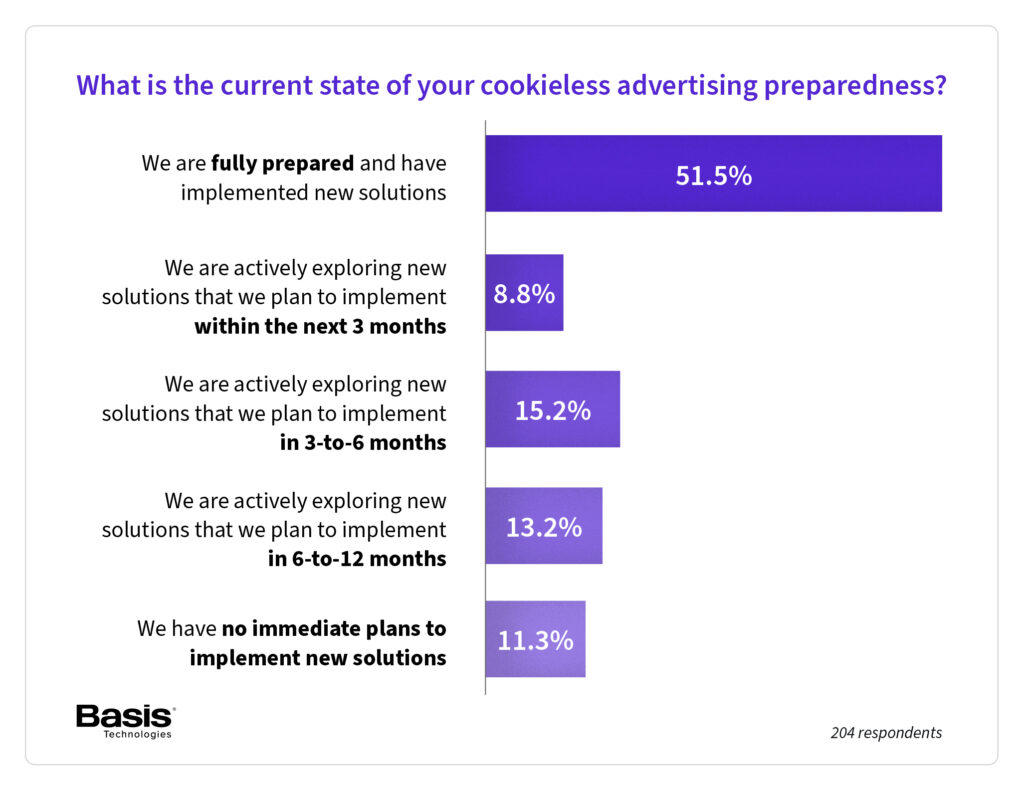Technology
Services
Resources

A look at the most popular privacy-friendly advertising solutions among marketers today—and the challenges awaiting those who won't adapt to the cookieless future.
Signal loss is more than just a buzzword. It’s the evolving challenge to connect meaningfully with audiences amidst a heightened focus on user data privacy, fueled by consumer demands, regulation, and major changes from tech giants. In 2024, signal loss is a pressing issue for all advertisers, but it’s particularly urgent for those who aren’t already actively adapting privacy-friendly strategies and solutions.
This year, signal loss will hit an inflection point as Google restricts third-party cookie access in its market share-leading Chrome browser. Advertisers have had quite a long runway to prepare for this pivotal year—so how well prepared are they for a world without the targeting and attribution afforded by cookies?
In surveying more than 200 marketing and advertising professionals from top agencies, brands, non-profits, and publishers, we found that 51% of marketers and advertisers feel their organization is fully prepared to succeed in a cookieless world. However, that leaves another 49% who don’t feel fully prepared—some say they’ll be actively exploring new solutions for as long as the next 12 months, and others have no immediate plans to implement new solutions at all.

So, how has that 51% of advertisers prepared for the death of cookies in Chrome? And what challenges are on the horizon for those who don’t implement privacy-first solutions as soon as possible? Read on for all the answers.
Let’s set the stage by exploring how we got here in the first place. In recent years, the issue of signal loss has grown due to factors including third-party cookie deprecation in browsers like Safari and Firefox, Apple’s App Tracking Transparency (ATT), and privacy-minded digital advertising regulations. Even before Google began cookie deprecation, these developments, driven by widespread consumer demand for increased control over personal data and more transparency over how it’s activated, stifled advertisers’ ability to target and track between 50 and 60% of internet users.
The loss of cookies in Chrome will further exacerbate signal loss, and the urgency of the matter seems clear to most advertisers: Close to 60% say they feel it’s extremely important to implement new identity solutions in the next six months.
Again, many marketers say they’re fully prepared for this seismic shift, with cookieless solutions in place today. What might advertisers who aren’t prepared learn from those who are?
Overall, addressing signal loss includes testing some of the privacy-first tactics that are helping marketers overcome targeting and attribution hurdles. Three front-runners—first-party data, lookalike audiences, and contextual targeting—are each already being used by 75% or more of surveyed marketers, and for good reason.
First-party data could be seen as the gold in the hills of the digital marketing landscape. By its nature, the act of collecting first-party data is privacy-friendly, and the process to activate it isn’t reliant on cookies. The efficiency it affords, not to mention its high level of relevance and opportunity for personalized messaging, makes it an attractive option. Further, the cookieless analysis of first-party data in a data management platform can be used for lookalike modeling, allowing advertisers to increase their addressable audience pool. And no less than 80% of marketers surveyed have begun using contextual targeting to serve targeted messages to prospective customers based on their content-based interests and intents.
Knowing these options are available, how can marketers best begin to embrace them? If the adage that “you can’t manage what you don’t measure” holds true, applying a test-and-learn mindset can help advertisers learn what cookieless solutions work best for their specific clients or brand. Here are a few examples of what advertisers in specific industries might try:
Ideas like these are cookieless, but they still reach all funnel stages, and their results can be compared to historicals or used as benchmarks for future campaigns.
As our digital world hurtles toward its cookieless destination, many advertisers have concerns about the efficacy of privacy-first and cookieless advertising. They’re anticipating the continued erosion of audience targeting and addressability, plus a path to measurement and attribution that’s littered with obstacles. But at the macro level, advertisers’ hesitancy to adopt the right solutions for the right reasons will only prolong their signal loss, with major efficiency and efficacy implications. These include:
The takeaway? Early adopters who invest in privacy-first solutions will set themselves up for competitive success, protect themselves from regulatory action, and build trust with privacy-conscious consumers.
As Google deprecates third-party cookies in Chrome, 2024 will be a pivotal year for signal loss, and advertisers can no longer delay adopting privacy-friendly and cookieless solutions for targeting and attribution.
The just-over-half of marketers who say they’re fully prepared for cookieless advertising have set themselves up for long-term success. On the other hand, for marketers who don’t identify and apply the right solutions soon, there will likely be consequences in store for their signal fidelity, their advertising campaigns, and even their bottom lines.
—
Want more insights on how marketing and advertising leaders feel about the state of signal loss? In our report, Identity vs. Privacy: Digital Advertising in a Cookieless World, we share results from our survey of more than 200 industry professionals, exploring the urgency to prepare now, beliefs about future advertising effectiveness, and how well current solutions truly address consumer and regulatory privacy concerns.